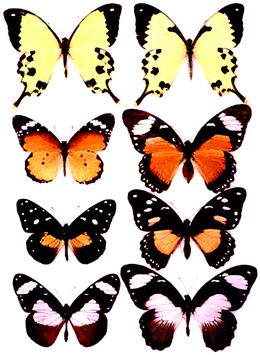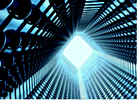Happy New Year from Lab on a Chip
Does progress in research need taxonomy?
Science and engineering is based on logic and knowledge, and convention means that knowledge gained from new experiments and discoveries is shared through literature publications. Published papers are expected to disclose all the necessary information to allow both readers to follow the author's ideas and conclusions, and experimentalists to repeat the experiment and verify the findings. This knowledge then serves as the basis for novel research activities, which are then published and so forth. I call this cycle research progress.It sounds a bit like a fairy tale, someone finding the time to read all the hundreds of years of published literature, doesn't it? And, it's getting still worse. Bibliometric investigations of funding bodies, the desires of commercial publishers, the egos of powerful professors and the advent of electronic publishing without peer-review, makes a further increase in publication activity unavoidable. The human brain is still the same and, indeed we are not keen to read all this material. Also, should we also read all the patent filings? They often document barely more than an idea, and some may later be proved incorrect. And, what about conference proceedings? Engineering conference proceedings come closer to the ideal, with more stringent peer-review of submitted abstracts that include figures and results. Other scientists often use only a paragraph or two of vague descriptions for conference abstracts. A few years ago, a Nobel prize was based on such a sketchy abstract which resulted in general unease in the scientific community about the award. When we plan our research, should we be considering available commercial products? I would like to mention the plethora of CE-on-chip results that are continually published which are much poorer than those that can be obtained using the commercially available Agilent Bioanalyzer. I suspect there is a need to re-think what we are currently doing in terms of research and to re-assess how we should proceed. We are responsible to society, because we spend billions in taxpayers money on our research, and even more so because we are the educators of future generations of scientists! Are we really being sufficiently responsible?
Fortunately, it is not all the fault of those of us doing research; funding bodies now tell us what to do. It's all about ‘nanotechnology’, or ‘systems biology’ or ‘flying to Mars’…. Do we really need all these buzzwords in order to obtain grants? Wasn't chemistry, physics, biology, electrical engineering, etc. good enough? Shouldn't the ideal cycle of experiment and publication lead us to the right areas of research and applications anyway? Or perhaps somewhere else?
Hirsch factors, impact factors and citations are all wonderfully simple and computable. But do researchers really want to live with complete chaos in the literature, with only a vague idea of the papers published in the past 5–20 years, and with a bibliometric funding landscape? Isn't there something distorted here?
Let's get more specific: the term ‘lab on a chip’. What on earth does this mean? Of course it makes a good title for a journal, but why would one use it as a term in a scientific publication? Does our journal define it? Perhaps it does? At least this confusion doesn't cause any problems for the progress of research.
Moving on to the next item: ‘repeating the experiment’. Our authors and peer-reviewers do a good job ensuring that the experimental sections of papers are comprehensive and that readers can repeat the experiment. … Do you get it? “… repeating the experiment”! During my whole career in ‘lab on a chip’ I have never seen this done. I have rarely even seen comparisons of different devices which are supposed to do the same thing. Researchers always seem to manufacture their own (new) systems and go back to the beginning rather than build on existing (proven) chip designs/systems. The few examples I can remember where this was not the case were manufactured by the same group in sequence. This makes it look as if (1) microchips are horrendously expensive, (2) manufacturing them is not reproducible, (3) all the different research groups consider each other to be enemies, (4) the devices are systematically destroyed by researchers after each experiment, (5) our students are particularly lazy, etc? Currently this community accepts that we just publish as ‘novel’ whatever the circumstances. Why not agree on a standard set of parameters to be measured, so that comparisons can be made? A kind of data sheet for each device layout performed on identical cell culture or chemistry? IUPAC would pay money for such an activity I am sure! I recently tried to convince a number of well known colleagues to participate in such an activity, sadly without success. Why are we researchers not keen on this idea? I honestly do not know. Should we start asking our graduate students to define terminology and contents of datasheets? Somebody should award a million pound prize to the team that succeeds as this will help develop and advance the field enormously.
Finally, the reviews on micro total analysis systems published in Analytical Chemistry. These reviews get a surprisingly high number of citations, and yet they offer no critical evaluation of the subject. The citations to these reviews have a steeper citation slope than some of the Nobel prize winners' best papers. Why is this? Could it be that the review’s attempt at taxonomy of manuscripts is helping the community? We all remember the days when we used books to determine the name of a flower or a beetle. Specialist entomologists classify over a million insect species using DNA, enzyme pattern, morphology and the latest statistics. Google uses an algorithm which brings up what we need in the jungle of the internet. In a similar way, a taxonomic approach to classification of manuscripts could identify nearest relatives to a given paper or an unpublished manuscript. What is the best way to search the literature? Keywords? I would love to be able to search by similarity of graphics and photos, or similarity of experimentation and conclusion logic. I am sure this will be possible one day. However, I am not an expert and would not know how to even initiate such a proposal. I would love to be able to feed a new manuscript into a computer program which then gives back a taxonomic descriptor. Perhaps not a Latin name (Linnaeus) but a number like the Hirsch factor. Google could then be used to search the entire scientific literature for all similar descriptors. Of course I assume that I'd have to sort the results out manually, because there might be random similarities (which by the way exist in insect taxonomy as well and are dubbed “mimicry”). Peer reviewers would be provided with a powerful tool to help with their decision, and boring/repetitious conference talks would become a thing of the past, as everyone could ascertain what had previously been published and not invite speakers intent on re-inventing the wheel.
 | ||
| Fig. 1 The photograph shows, on the bottom three rows, unpalatable butterfly model species in the family Danaidae (left) and palatable mimetic forms of female Papilio dardanus (right), an African swallowtail species. Top left is the Papilio dardanus male; top right is a non-mimetic, male-like female of the same species. Photograph taken by Bernard D’Abrera © 2000 and reproduced with permission from James Mallet (see http://www.ucl.ac.uk/taxome/jim). | ||
On a more positive note, I am sure that we have a bright future, but we will have to create it for ourselves and we'd better start now! Lab on a Chip is therefore taking action, providing help with a few simple actions. For example, authors are being encouraged to supply their original mask files for publication as Electronic Supplementary Information (ESI). Perhaps we should team up with microchip foundries and provide a button on the website which can be used to order the device in small numbers? The RSC is also going to bring together all the Editorial Boards of all their journals in a single ‘Editor’s Symposium’ meeting in Brussels next February where the LOC board will discuss exactly the above matters. And we will do more… I am sure… but then I am a terrible optimist!
Andreas Manz
Chair, Lab on a Chip Editorial Board
New developments at the Royal Society of Chemistry
Lab on a Chip continues to see a phenomenal growth in submissions as the reputation of the quality of the journal reaches an ever wider audience; submissions received by the end of September 2006 had exceeded the total number received in 2005.Lab on a Chip papers are published in an average of 85 days from receipt—these are the fastest publication times in the field, with our nearest competitors taking a minimum of 35 days longer. This is a direct consequence of the highly qualified and professional staff at the RSC, who are committed to providing the best service in the field in terms of friendliness and efficiency.
The journal also takes pride in playing its part in advancing scientific endeavour and to this end we have developed a unique web resource entitled “Chips and Tips” that provides practical tips and tricks to solve everyday laboratory issues that never see the light of day in full research publications. Thus helping newcomers to the field and experienced scientists get on with the real science.
In addition, 2006 saw the presentation of the first “Pioneers of Miniaturisation” Prize sponsored by Corning Incorporated and Lab on a Chip to encourage and promote the work of young to mid-career scientists to the wider scientific community and highlight the benefits of miniaturised technologies (see below for a full list of LOC sponsored prizes and awards).
RSC Open Science
Authors publishing in RSC Journals now have the option of paying a fee in exchange for making their accepted communication, research paper or review article openly available to all via the web, with RSC Open Science. The scheme is only made available to authors once their papers have been accepted for publication, following the normal rigorous peer-review procedures (RSC Open Science operates in parallel with the normal publication route, which remains free to authors). Authors who have published their work in RSC journals are also able to retrospectively apply for their work to be included in the scheme. Further information can be found at: www.rsc.org/openscience.
Technological innovation
2006 has seen RSC Publishing invest significantly in technological developments across all of its products. Introduced last year, RSS feeds, or ‘really simple syndication’, have proved extremely popular with our readers. Subscribers receive alerts as soon as an Advance Article is published in their journal of choice, providing both the graphical abstract and text from a journal's contents page. You can subscribe via the Lab on a Chip homepage.Subscribers to Lab on a Chip will now link from journals' contents lists straight through to the HTML view of selected articles, in just one quick step. Here you can download references to citation managers (such as EndNote, Ref Manager, ProCite and BibTex), sign up for RSS feeds, search for citing articles (otherwise known as ‘forward linking’), print the article with just one click and send the article to a friend or colleague.
From 2007, authors publishing in RSC journals will see their science “come alive” thanks to an exciting new project pioneered by the RSC. Enhanced HTML in RSC articles will allow chemical and biological compounds mentioned in the text to be identified; by clicking on the compound readers will be able to obtain further information about that compound, including a downloadable structure plus a list of relevant subject areas. The RSC is the first publisher to utilise the International Chemical Identifier (InChI) (a digital equivalent of the IUPAC name for any particular covalent compound where structures are expressed in terms of five layers of information—connectivity, tautomeric, isotopic, stereochemical, and electronic) for a project of this type and scope. The technology will be used to enhance RSS alerts so that future news feeds can include chemical structures and other enhanced information. RSC Publishing intends to evolve this project to match author and reader needs so tell us what you think: we welcome your feedback on this new functionality and will incorporate your ideas to develop the service further. Find out more at www.rsc.org/sciencecomealive.
These developments demonstrate the investment in publishing products and services over the past year and 2007 will see us enhancing our products further.
Impact factors and immediacy index
The 2005 impact factors, released by ISI® in June 2006, showed an impressive average increase of over 10% for RSC Journals. Lab on a Chip continues to rise in impact increasing from 5.0 to 5.3 in 2005.Calculated annually, ISI® impact factors provide an indication of the quality of a journal—they take into account the number of citations in a given year for all the citeable documents published within a journal in the preceding two years.
Work published in RSC Journals is also amongst the most topical. The immediacy index measures how topical and urgent papers published in a journal are, by dividing the number of citations in a given year by the number of articles published in the journal that year. The LOC immediacy index stands at 0.996 for 2005 indicating that almost every article is cited in its year of publication. These impressive new figures reinforce the RSC's reputation as the home of exciting new research.
Changes and developments to Chemical Science, Chemical Technology, Chemical Biology and Chemistry World
Showcasing hot science from RSC Journals in Chemical Science, Chemical Technology and Chemical Biology has proved very popular with readers and authors alike. In fact, the free supplements have become so successful that from January 2007, all issues will be eight pages (in print), contain new article types and come complete with a fresh new look for the front page. Supplementary material will also be available online.Meanwhile Chemistry World, the RSC's award-winning magazine, launched two new web features at the end of 2006. The Chemistry World Blog is an interactive forum for news, discussion and opinion, looking at the science hitting the headlines. The Chemistry World Podcast interviews high profile scientists about the latest and hottest topics in science, and is free to download at www.rsc.org/chemistryworld.
LOC prizes and awards
Lab on a Chip actively supports the research community and we do our utmost to support new talent and new research. Consequently, we encourage a variety of conferences through sponsorships, student awards and prizes all over the world. For example, in 2006 LOC sponsored the IEEE–EMBS International Conference on Microtechnologies in Medicine & Biology meeting in Okinawa, Japan; sponsorship and student awards at the Gordon Conference on MEMS Technology & Biomedical Applications held in Connecticut, USA; a Pioneers of Miniaturisation Award and the Widmer Prize at the μTAS International Conference on Miniaturized Systems for Chemistry and Life Sciences, Tokyo, Japan; and student awards at Nanotech 2006 held in Montreux, Switzerland.
These prizes/awards and sponsorships are amongst the many awarded by RSC Publishing in 2006, a year that has seen more than 20 high-profile researchers gain financial support to present their work at events throughout the world, in recognition of their research achievements. More than £15,000 (or $30,000) was granted to the recipients, in total, to cover travel expenses to sponsored lectureships in countries such as China, Japan, US and UK.
LOC intends to sponsor further conference awards and prizes in 2007.
Nanoscience from RSC publishing
LOC papers dealing with nanotechnologies will now also appear on our Nanoscience webpage, but it is not just LOC that is publishing high-quality papers on the topic—due to the interdisciplinary nature of the subject other RSC journals and books also include related content. This wealth of nano material has now been brought together in one convenient webpage, which is regularly updated with the latest research and books from RSC Publishing. Visit: www.rsc.org/publishing/journals/nanoscience.
In addition, RSC Publishing is pleased to announce the launch of the RSC eBook Collection. RSC books are now available online and can be easily downloaded as either chapters or books. The collection is fully searchable and also integrated with RSC journal content. To search the collection or for further information, visit www.rsc.org/ebooks.
Molecular BioSystems now in MEDLINE
Molecular BioSystems continues to strengthen its position and has had an excellent year. From bioanalytical and highthroughput techniques, microarrays and chip-based microfluidic technologies, to proteomics and biomarkers, the journal focuses on the interface between chemistry, the –omic sciences and systems biology. The journal is now indexed in MEDLINE, thus improving visibility in the community. Subscribers to Lab on a Chip in 2007 will continue to receive free online access to Molecular BioSystems (www.molecularbiosystems.org).Soft Matter
It's official, Soft Matter has separated from host journal, Journal of Materials Chemistry, and is now a fully fledged solo publication. Its availability since launch to readers of Journal of Materials Chemistry and the online hosts, Physical Chemistry Chemical Physics, Organic & Biomolecular Chemistry and Lab on a Chip, has ensured that Soft Matter received a large and interdisciplinary audience from the outset. Lab on a Chip readers wishing to continue to read Soft Matter now need to recommend the journal to their librarian. Fill in the online recommendation form at www.rsc.org/libraryrecommendation.What our authors say
We are always happy to receive feedback from authors, especially if it helps us to further improve the publishing experience. Because we believe that RSC Publishing offers the best service of any scientific publisher, we have published a selection of the comments we have received from authors from around the globe—take a look at www.rsc.org/authorquotes.Harp Minhas
Editor, Lab on a Chip
| This journal is © The Royal Society of Chemistry 2007 |




